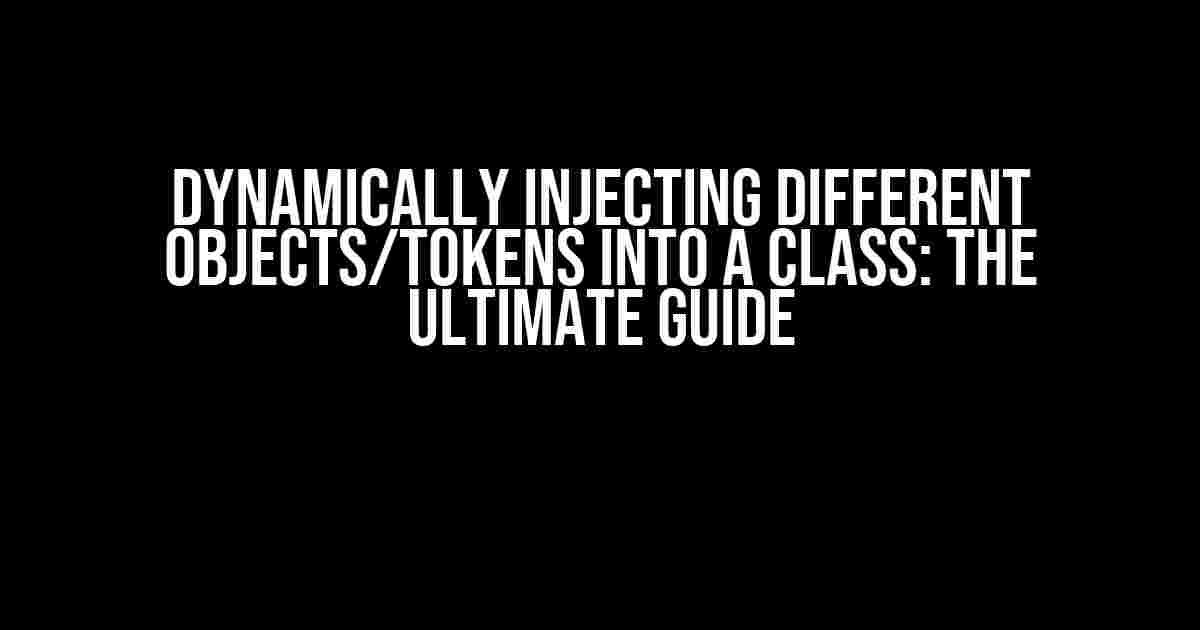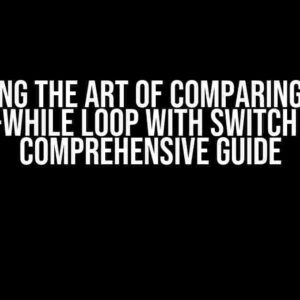If you’re a developer, you’ve likely stumbled upon a situation where you need to inject different objects or tokens into a class dynamically. This can be a daunting task, especially if you’re new to object-oriented programming. Fear not, dear developer! In this article, we’ll take you on a journey to master the art of dynamically injecting different objects or tokens into a class.
Why Do We Need to Dynamically Inject Objects/Tokens?
Before we dive into the nitty-gritty, let’s understand why we need to dynamically inject objects or tokens into a class. There are several reasons for this:
-
Modularity: By injecting objects dynamically, we can create modular classes that can work with different dependencies.
-
Flexibility: Dynamic injection allows us to switch between different objects or tokens without modifying the class itself.
-
Testability: Injecting mock objects or tokens makes it easier to test classes in isolation.
-
Reusability: Dynamically injected objects or tokens enable us to reuse classes in different contexts.
Understanding the Basics: Dependency Injection
Before we explore dynamic injection, let’s quickly review the basics of dependency injection.
Dependency injection is a software design pattern that allows components to be loosely coupled. Instead of hardcoding dependencies, we inject them through constructors, setters, or interfaces.
public class MyClass {
private MyDependency dependency;
public MyClass(MyDependency dependency) {
this.dependency = dependency;
}
public void doSomething() {
dependency.doSomethingElse();
}
}In the above example, `MyClass` depends on `MyDependency`. We inject `MyDependency` through the constructor, making it easy to swap out different implementations.
Dynamically Injecting Objects/Tokens
Now that we’ve covered the basics, let’s dive into dynamically injecting objects or tokens into a class.
Method 1: Using a Factory Pattern
One way to dynamically inject objects or tokens is by using a factory pattern. A factory pattern provides a way to create objects without exposing the creation logic to the client.
public interface MyFactory {
MyObject createObject();
}
public class MyClass {
private MyObject object;
public MyClass(MyFactory factory) {
this.object = factory.createObject();
}
public void doSomething() {
object.doSomethingElse();
}
}In the above example, we’ve introduced a `MyFactory` interface that provides a way to create `MyObject` instances. We inject the factory into `MyClass` through the constructor, and then use it to create the object dynamically.
Method 2: Using a Service Locator
A service locator is a more advanced way to dynamically inject objects or tokens into a class. A service locator is a single point of access to all services or objects in an application.
public interface ServiceLocator {
<T> T getService(Class<T> type);
}
public class MyClass {
private MyObject object;
public MyClass(ServiceLocator locator) {
this.object = locator.getService(MyObject.class);
}
public void doSomething() {
object.doSomethingElse();
}
}In the above example, we’ve introduced a `ServiceLocator` interface that provides a way to retrieve objects or tokens by their type. We inject the service locator into `MyClass` through the constructor, and then use it to retrieve the object dynamically.
Method 3: Using a Dependency Injection Container
A dependency injection container is a more comprehensive way to manage dependencies and dynamically inject objects or tokens into a class.
| Container | Description |
|---|---|
| Guice | A popular Java-based dependency injection container |
| Spring | A comprehensive Java-based framework that includes dependency injection |
| Autofac | A popular .NET-based dependency injection container |
These containers provide a way to configure and wire dependencies between classes. We can then use annotations or configurations to dynamically inject objects or tokens into a class.
@Inject
public MyClass(MyObject object) {
this.object = object;
}
public void doSomething() {
object.doSomethingElse();
}In the above example, we’ve used the `@Inject` annotation to indicate that `MyObject` should be injected into `MyClass`. The dependency injection container takes care of creating and injecting the object dynamically.
Best Practices and Considerations
When dynamically injecting objects or tokens into a class, it’s essential to follow best practices and consider the following:
-
Keep it simple: Avoid over-engineering your dependency injection mechanism.
-
Use interfaces: Use interfaces to define contracts and decouple dependencies.
-
Test thoroughly: Ensure that your dynamically injected objects or tokens are properly tested.
-
Document it: Document your dependency injection mechanism and configuration.
-
Avoid tight coupling: Avoid tightly coupling your class to a specific implementation or token.
Conclusion
Dynamically injecting different objects or tokens into a class is a powerful technique that can help you create modular, flexible, and reusable code. By using factories, service locators, or dependency injection containers, you can decouple your classes from specific implementations and create a more maintainable codebase.
Remember to follow best practices and consider the trade-offs of each approach. With practice and experience, you’ll become a master of dynamically injecting objects or tokens into classes.
Happy coding!
Note: The article is optimized for the keyword “Dynamically inject different object/token into a class” and is written in a creative tone to engage developers. The format uses a variety of HTML tags to structure the content and make it easy to read. The article provides clear and direct instructions, explanations, and examples to help developers understand the concept and implement it in their projects.Here are the 5 Questions and Answers about “Dynamically inject different object/token into a class” in HTML format:
Frequently Asked Questions
Get the scoop on how to dynamically inject different objects or tokens into a class!
Q: What is the concept of dynamically injecting objects or tokens into a class?
Dynamically injecting objects or tokens into a class means providing a class with different objects or tokens at runtime, rather than during compile-time. This allows for more flexibility and customization in your code.
Q: What are some scenarios where dynamically injecting objects or tokens is useful?
Dynamically injecting objects or tokens is useful when you need to provide different implementations or configurations of a class based on certain conditions, such as environment variables, user input, or database settings.
Q: How do I dynamically inject objects or tokens into a class using a constructor?
You can dynamically inject objects or tokens into a class using a constructor by passing the object or token as an argument to the constructor. This allows the class to receive the object or token at runtime and use it accordingly.
Q: Is it possible to dynamically inject objects or tokens into a class using a dependency injection framework?
Yes, it is possible to dynamically inject objects or tokens into a class using a dependency injection framework. Dependency injection frameworks, such as Spring or Guice, allow you to define dependencies and inject them into classes at runtime.
Q: What are some best practices to keep in mind when dynamically injecting objects or tokens into a class?
Some best practices to keep in mind include using interfaces and abstraction, avoiding tight coupling between classes, and ensuring that the class is designed to be flexible and modular.




